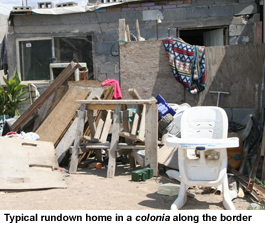


|
|
|
|
|
|
|
|
|
|
|
|
||||||||||||||
|
||||||||||||||
|
|
||||||||||||||
|
||||||||||||||
|
The scene was “unbelievable,” she recalls, reflecting on her one-month stay in Laredo, TX as a student at the South Texas Environmental Education and Research Center. The center, better known by its acronym STEER, is a part of the University of Texas Health Science Center at San Antonio.
“If you’re interested in international health or U.S. Mexican border issues it’s the perfect program,” said Meetze, the first student from USC’s Arnold School of Public Health to enroll. The clothing she observed littered along the riverbank was the most unusual sign of the illegal border crossings that have strained U.S.-Mexican relations in recent years. Despite the best efforts of the border patrol with its sensors, cameras and helicopters, immigrants pack their belongings in plastic bags and swim across the Rio Grande, changing clothes when they reach the U.S. side. Laredo and its companion Mexican city, Nuevo Laredo, are both gritty border towns but together have a major economic impact.
Altogether an estimated 10 million people live along the 2,000-mile U.S. Mexican border that stretches from San Diego to Brownsville, TX.
She also wanted a cognate as part of the requirement for her doctorate which she hopes to acquire in about two years. She already has a bachelor’s degree from the Medical University of South Carolina and a master’s degree from the Arnold School. She currently is coordinator for the Women’s’ Well-being Initiative offered through the USC Women’s Studies Program. As a South Carolina resident, Meetze said she thought she lived in a hot climate until she arrived in Laredo. “I’ve never experienced such heat in my life,” she said. The National Weather Service says the city’s average maximum temperature in July is 99.99 degrees. Meetze says her classes during the program were taught by a variety of faculty members from the University of Texas, the Centers for Disease Control, the U.S. Border Patrol and public health officials from Mexico. The group traveled to Nuevo Laredo where Meetze said she was impressed with Mexico’s public health efforts. “When I read the literature and watch TV there’s the impression that the Mexican public health system isn’t that good. But I was impressed. “They have programs for the poor, very good immunizations rates for children. They have a rabies program where they go door to door to vaccinate animals,” she said. The rabies program was a dramatic example of the differing standards between the U.S. and Mexico, she said. U.S. law requires a veterinarian to be present during a vaccination whereas in Mexico the shots can be administered by a nurse alone. Nevertheless, despite the best efforts of public health authorities, many of the region’s residents remain in dire poverty, subject to emerging and re-emerging infectious diseases, rapid growth and industrialization. She said the spread of dengue fever was encouraged because so many homes in the area were littered with old auto tires, convenient basins to catch rainwater and for mosquitoes to hatch their larvae. Meetze said the STEER program is a busy one with classes and field trips to water and waste treatment plants, a recycling operation, a sanitary landfill, a restaurant inspection site and border area neighborhoods called colonias. One day was devoted to a field trip with an herbalist to learn more about folk medicine in the area. Another day found the students wading into the Rio Grande to take water samples. The students visited the colonias on both sides of the border where they observed a wide range of living conditions. There are some 1,300 colonias along the border in Texas and New Mexico where some 300,000 people live in substandard housing with inadequate plumbing and sewage disposal system. Also there is inadequate access to clean water and general sanitation and health conditions compare with those in Third World countries. For more information: • South Texas Environmental Education and Research (STEER) Center |
| Columbia, SC 29208 • 803-777-7000 • sphweb@gwm.sc.edu | © University of South Carolina Board of Trustees |

